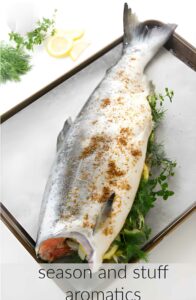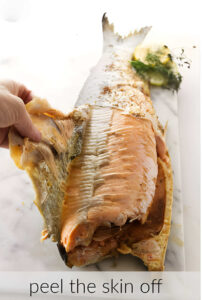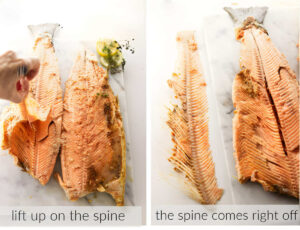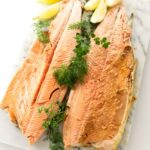How to Bake a Whole Salmon
Baking a whole salmon is incredibly easy. The brine is optional but will keep the fish very moist and tender. The brine also seasons the fish thoroughly and prevents that white albumin that seeps out of the salmon as it cooks.
Servings: 6 servings
Ingredients
For the Brine (optional)
- 4 quarts cold water see notes
- 1 cup Kosher salt
- ½ cup brown sugar
For the Baked Salmon
- 1 whole salmon 3 to 5 pounds
- 2 to 3 tablespoons olive oil
- 2 tablespoons seasoning salt
- 1 onion thinly sliced
- 1 fennel bulb thinly sliced or shaved with a veggie peeler
- 8 to 10 garlic cloves thinly sliced
- 2 lemons thinly sliced
- fresh parsley
- Fresh dill
- Fresh thyme
Instructions
Brine the Salmon (optional)
- Combine the sugar, salt, and 3 to 4 cups of water in a saucepan. Bring to a simmer and stir until the salt dissolves. Cool the solution down by tossing in a couple of cups of ice cubes. Pour the solution into a container large enough to hold the salmon. Pour in the rest of the water.
- Place the salmon in the brining solution. Cover and place in the fridge for 6 to 8 hours (Make sure the brine covers the salmon. If it doesn’t, make some additional brine solution).
Bake the Salmon
- Preheat the oven to 425°F and pat the salmon dry with paper towels. Place the salmon on a baking sheet lined with parchment paper.
- Brush olive oil on the outside and in the cavity of the salmon then sprinkle it generously with seasoning salt. Stuff the cavity with slices of onion, fennel, garlic, lemon, and several sprigs of the herbs.

- Transfer to the oven and bake for 20 to 30 minutes or until a meat thermometer registers 130°F (or 122°F for rare salmon, see notes).
Serve the salmon
- Place the salmon on a wide platter. Pull up on the skin. It will peel off very easily.

- Starting at the head end, lift up on the spine with a wide spatula or knife. The top fillet and the spine will peel off of the lower fillet. (See the photos in the post for reference). Flip the top fillet over so the spine is on top. Pull the spine off the top fillet. Use the spatula to hold the flesh down under the spine.

- Season the salmon with salt and pepper and serve.
Notes
Brining Tips: If you choose to brine the salmon, use enough water to fully submerge it. The amount you need depends on the size of your salmon and the container. For extra brine, add 1 tablespoon of salt and 1 teaspoon of sugar per additional cup of water.
Why Brine? Totally optional, but worth it. Brining boosts flavor, keeps the fish juicy, and helps prevent that white albumin from showing up on the surface. We used a brine for our Copper River salmon and it turns out fantastic.
Target Temperature: The FDA recommends 145°F, but salmon gets dry fast at that point. We prefer 122°F to 130°F for tender, juicy results. Use your judgment and cook it how you like it.
Serving Tip: Once it’s cooked, the fillets lift away from the bones easily. The more well-done it is, the easier they’ll separate. If it’s rare, you might need to nudge it loose with a knife.
Nutrition
Serving: 1 serving | Calories: 169kcal | Carbohydrates: 17g | Protein: 7g | Fat: 9g | Saturated Fat: 1g | Polyunsaturated Fat: 7g | Cholesterol: 18mg | Sodium: 8138mg | Fiber: 1g | Sugar: 13g
